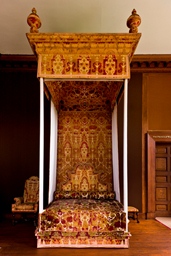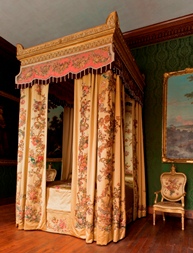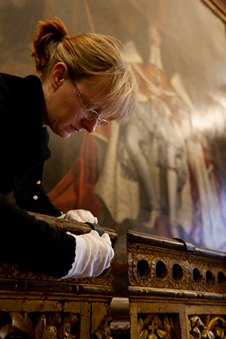Hampton Court is a Palace of two halves – with Henry VIII’s Tudor Palace at the front and Christopher Wren’s magnificent Baroque Palace to the back. Historic Royal Palaces, the charity who also manage the Tower of London, Banqueting House, Kensington and Kew Palaces are turning their attentions to the transformation of Hampton Court’s Baroque Palace. And where better to start than the ultimate destination in the palace – the royal bedchamber?
1660 -1760 – The heyday of the royal bedchamber
For 100 years the Royal Bedchamber was the very heart of the Baroque Palace, so much so that all of the State Rooms lead to it. Here the lucky courtier or politician would be received by their King, who would perhaps be reclining on his piles of mattresses, being shaved by his personal barber or supping his breakfast from an ornate gold bowl. These and other bizarre rituals comprised the morning lever, or rising ceremony, whereby the King’s personal elite servants – always titled gentlemen and life-long loyal individuals – would attend him in his bedchamber. These ceremonies were in fact, all for show, designed to display the King’s wealth and power and bestow privilege on those lucky few who were granted permission to witness this display.

Very few of royal beds were even used as they were to all intents and purposes, for showing off royal power and prestige. The monarch would be put to bed during the coucher ceremony – a reverse of the morning’s lever ceremony – and once his audience had left he would slip next door to his private bedchamber, and smaller private bed.
At a time when the monarch was still considered God’s representative on earth, access to the King was the ultimate privilege. Through the important life events that took place in the royal bedchamber, the exhibition explores the dichotomy between the public display of intimate rituals and the real privacy of the monarch. Odd as it may seem, everything that took place in the royal bedchamber was witnessed by a party of courtiers, politicians and close family members. Childbirth, death and even the wedding night of the royal couple was witnessed in order to reinforce the monarch’s true claim to the throne. From the bed that witnessed the birth of the Old Pretender, James Frances Edward Stuart, to Queen Anne’s State Bed, possibly designed as her death bed, each of the royal beds provides a window in to the complex relationship between the public and private life of a monarch.

From Charles II’s return from exile to claim the English throne, to the arrival of George III, this 100 year period saw huge political changes. The monarchy went from having absolute power to shared control with Parliament. Each successive monarch gradually acceded more power to parliament and this ultimately meant that the royal person had limited personal rule. As the monarch’s power decreased the bedchamber rituals became outdated. By the time George III came to the throne in 1760 politics had moved out the bedchamber and the rituals had lapsed completely. The age of the royal bedchamber was over.
A bed fit for a Queen
These royal beds were far more than just magnificent objects; they were the seat of royal power and the stage from which the King ruled the country. This importance is reflected in their ornate design and exorbitant cost – Queen Charlotte’s beautifully embroidered bed cost the equivalent of 10 good London town houses and took six years to make. However, by the time that this fabulous bed was completed politics had left the bedchamber entirely, the privy purse had been cut and no great bed was ever commissioned again on such a scale.

Exhibition super route
A new ‘super route’ has been created at Hampton Court for the Secrets of the Royal Bedchamber exhibition which occupies the Queen’s State Apartments. For the first time visitors can journey from the huge magnificent State Rooms into the intimacy of the smaller Queen’s private apartments. Additionally, the hidden gem of the Prince of Wales Suite is also open for the first time in a generation. Working with a team of exhibition designers including Universal Design Studio, Historic Royal Palaces set themselves a challenging task, coupling large fragile artefacts with a complex political and historical narrative to arrive at an experience which would engage and intrigue visitors.
Embracing the opportunity to experiment with new approaches to display and find ways to engage audiences with the stories of the beds, the exhibition takes a contemporary twist on the themes of the Baroque aesthetic; embellishment, reflection and bombast. The beautiful chandelier which opens the exhibition is designed by Studio Roso and is inspired by these principles.
50 years of Conservation
Whilst these beds tell a story of political upheaval and social change they also tell a story of changing conservation practice. From the earliest work over 50 years ago, which involved restoration to make the beds look as good as new to more contemporary conservation and consolidation practice aimed at preventing further deterioration of the beds.

Displaying these royal beds together for the first time ever is a great opportunity for Historic Royal Palaces to showcase the incredibly intricate work of their in house conservators, as well as the pioneering techniques used to preserve the beds.
Beds but not as you know them
These beds are the stuff of fairy tales – mattresses piled high, magnificent gilded four posters, lofty canopies and luxurious bedding. Their incredible design is a testament to a bygone age when kings and queen’s ruled from their bedchamber and the events of the royal bed influenced society at large.
Visit Hampton Court Palace before 3rd November to see Secrets of the Royal Bedchamber.
Back to top




